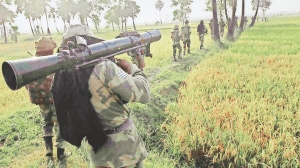People without borders
PESHAWAR, JAN 1: "This is where Pakistan ends, here begins Pashtunistan," says Ismarai as the bus heads west across the Indus b...

PESHAWAR, JAN 1: "This is where Pakistan ends, here begins Pashtunistan," says Ismarai as the bus heads west across the Indus bridge at Attock.
The student laughs, knowing full well that there is no independent country by the name of Pashtunistan. This is merely the border where Punjab province ends and North-West Frontier Province begins — both of them in Pakistan.
But here the inhabitants are almost exclusively Pashtuns (Pathans), as is also the case across the border into Afghanistan. On both sides of the border the people speak Pashto.
The feeling that they belong together is strong and links have become closer since millions of Pashtuns fled the war in Afghanistan across the border into Pakistan — including illegal links like smuggling.
An Afghan trader in Peshawar in Pakistan merely laughs at the question whether he wants a Pashtunistan. "What do you mean, want? We already have it. The border is irrelevant."
The trader does business on the Karkhano market, which is also known as thesmugglers’ market. Every imaginable consumable is for sale here, smuggled in through Afghanistan. The goods get here in part by air freight from the Gulf states and in part by truck in transit through Pakistan.
The smuggling is aimed at evading Pakistani import duties.
"Opium also reaches Pakistan from Afghanistan by this route and is sold here for sale elsewhere," says one Pashtun who is as at home here as he is in Jalalaabad on the other side of the border.
The Taliban tolerates the cultivation of opium in Afghanistan because it helps to fill the state coffers for the war it is fighting. And weapons are among the smuggled goods.
Bordering the market there is a huge refugee camp that looks like an Afghan village, only a hundred times bigger, with mud walls enclosing small plots.
Many women cover their heads and upper bodies under the chador when they go to the market, but at home they listen to music, watch television and send their daughters to school. On the other side of the border theTaliban has forbidden all of this, but it is doubtful whether the refugees would accept this if they were to return to their homes.
"There must at least be a school for my daughter," says a teacher who fled Afghanistan as a child with his parents and studied in Pakistan.
To the west of Peshawar the border area begins. The border divides Pashtun land and is an artificial one. It was drawn by the British in 1893 and known as the Durand Line. The wild north-west’ of what was then British India was scarcely amenable to control and this remains the case to this day.
The green — or more accurately dusty — border between Afghanistan and Pakistan is in the hands of the mountain people. The smugglers’ trail runs through the almost impassable Khyber Pass, while the official road leads to the border village of Torcham.
At this point Ismarai leaves the bus from Pakistan, walks a short distance on foot and climbs onto an Afghan bus that will take him to his parents in Jalaalabad.
"Here I never have to show mypassport," he says.
Nobody bothers anymore about demanding a Pashtun homeland. The Awami national Party has abandoned its call for this, nor does the Taliban currently show much interest in incorporating a part of Pakistan in its territory.
"We do not interfere in the internal affairs of other countries," Taliban information Minister Amir Chan Muttagi says.



- 01
- 02
- 03
- 04
- 05




























